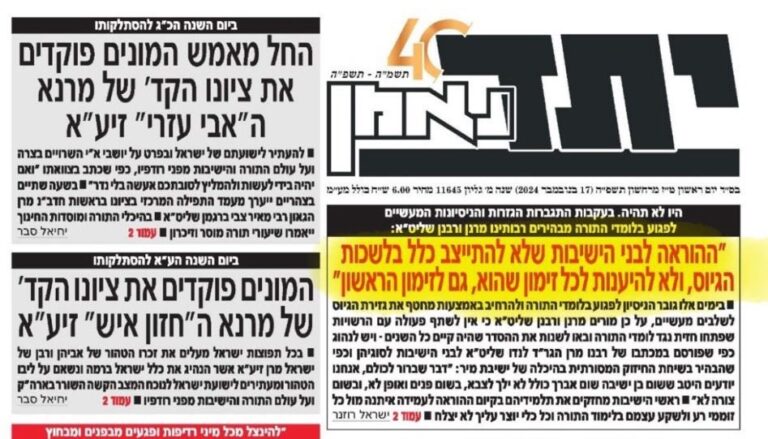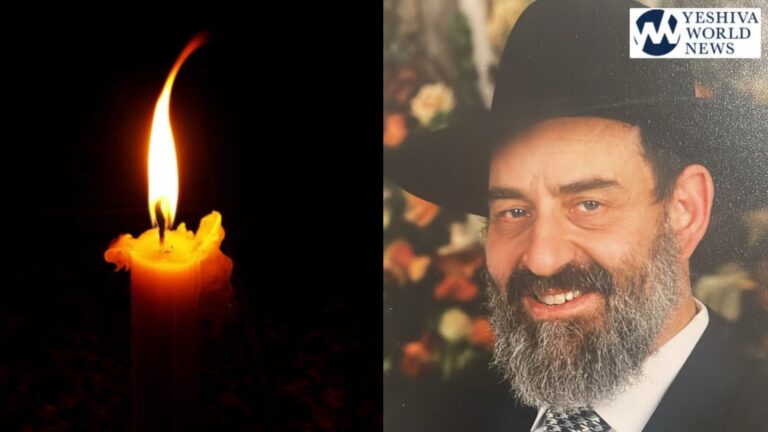 [By Rabbi Yair Hoffman]
[By Rabbi Yair Hoffman]
THE MITZVAH
Mordechai and his Beis Din enacted that on the day of Purim each person must send a gift of at least two portions of food to a friend. This is seen from the verse in Megilas Esther, “Umishloach manos ish l’reyehu.”
THE REASONS
What is the reason behind the mitzvah of shalach manos? Two reasons are brought down. The Terumas HaDeshen (Siman 111) writes that it is to ensure that the recipients not run out of food items to serve for their meals.
The Manos HaLevi on Megillas Esther (9:19), written by Rav Shlomo Alkabetz and cited by the Chasam Sofer, writes an altogether different reason: to increase peace and brotherly love. This is the opposite of the characterization of the Jewish people by Haman as a nation “Mefuzar umefurad” spread and standing apart on account of internal arguments.
PREAMBLE AND INTENTIONS
The Yesod v’Shoresh HaAvodah writes that one should recite the following preamble before fulfilling the Mitzvah:
לשם יחוד קודשא בריך הוא הריני מוכן ומזומן לקיים מצות עשה של דברי קבלה “ומשלוח מנות איש לרעהו.”
When performing the Mitzvah one should not just perform it perfunctorily, but should focus on the qualities of the recipient and place within his heart a strong love for his fellow man. He should intend to honor him and to strengthen his inner joy with this package of Shalach Manos.
WHO IS OBLIGATED
Men and women are both included in this mitzvah. The halachah is that men send to men, and women send to women. Women are obligated in the mitzvah because, according to the Mishnah Berurah, “they too were involved in the miracle.” A child should be instructed to fulfill the Mitzvah just as one instructs a child to fulfill all the other Mitzvos. The child may send to another child, as the other child is considered his or her peer.
Even a poor person is required to fulfill the mitzvah of mishloach manos. The mitzvah of mishloach manos may not be fulfilled with money, clothing, or other non-food or non-drink items. The mitzvah may only be fulfilled with kosher items.
HOW FANCY
Another little-known halachah about shalach manos is found in an esoteric Biur Halachah (written by the Chofetz Chaim) in Orach Chaim 695. He writes that the Chayei Adam has proved from a passage in the Talmud Yerushalmi that if one sends a Purim package to a wealthy individual, the package must be a respectable one.
Thus, one should not send something below the kavod of the recipient. The poskim have ruled that a lollipop is not considered chashuv for an adult, nor is a bottle of Poland Spring water or seltzer. To fulfill the Mitzvah, the portions must convey sufficient regard for the recipient.
The Biur Halachah writes that the Ritva’s comment on his version of the Talmud Bavli agrees with the Chayei Adam. A careful reading of the Ritva, however, reveals that the Ritva and Chayei Adam are not exactly the same. Both of them require an upgraded Purim package on account of wealth; of that there is no question. However, the Ritva’s requirement is of the wealth of the giver—not the recipient. In other words, according to the Ritva, if the giver is very wealthy, his package must reflect that as well and he cannot fulfill the mitzvah with a meager package. Since the Biur Halachah does quote both the Chayei Adam and the Ritva, both would seem to be authoritative.
Therefore, one should not send something below the kavod of the giver or the recipient.
NATURE OF THE PACKAGE
The mitzvah must be fulfilled only with foods that are immediately edible or drinkable. The Magen Avraham, Vilna Gaon, and Chayei Adam hold this way. The Pri Chadash is lenient. We rule in accordance with the former view.
An item that requires further cooking or preparation may be added, but two immediately usable foods must be included, too. It is praiseworthy to send portions to as many friends as possible. It is better, however, to give more matanos la’evyonim than to give more mishloach manos to friends.
THE TWO BLESSINGS MYTH
There is no need for the two different food items to have two separate berachos. This is one of the biggest misconceptions in Hilchos Purim. There is an issue, however, of taking one food item and cutting it in half into two slices. The Aruch haShulchan (OC 695:14) writes that just because one cut it in half it should be considered two foods? Perhaps it is this statement of the Aruch HaShulchan that has caused the two blessing myth to exist. If someone sends another two pieces of meat from two different limbs that tastes slightly different this is considered two foods (Mikraie Kodesh SIman 38).
THROUGH A MESSENGER
Ideally, mishloach manos should be sent through a messenger, rather than be delivered personally. Generally speaking, we say, “Mitzvah bo yoser mi’b’shlucho” — it is a bigger mitzvah to do it oneself rather than through a messenger. Regarding the search for chametz before Pesach, it is better to do it oneself. Here, though, it is different. The Chsam Sopher writes in his commentary to the Talmud (Gittin 22b), that the pasuk says, “and the sending of gifts – mishloach manos” which indicates that it should be done through a messenger. A gift sent through a messenger is fancier and nicer. If one did deliver the mishloach manos oneself, the obligation is still fulfilled.
Virtually all the poskim rule that a goy or a child may be a shaliach for mishloach manos. Rabbi Akiva Eiger, zt”l, was unsure of this, however.
SENT TOGETHER
Must the two foods be sent together? Rav Elyashiv zt”l is of the position that they must. May one of the foods be a liquid? Most authorities hold that one of the foods may certainly be a liquid (except for water), and this is the authoritative view. There is a reading of Rabbeinu Chananel that holds a liquid may not be one of the two food items. This view is apparently not l’halachah.
GIFT CERTIFICATES
Does sending money to buy food or sending a gift certificate at a restaurant work? Some Acharonim hold that it does, but many hold not. The language of the Rambam (Hilchos Megillah, Chapter 2) seems to indicate that it must be real food and not a gift certificate or money.
REFUSAL OF GIFT
What if a package is prepared and the recipient responds with a “No, thank you?” Has the sender fulfilled the mitzvah in such a case? According to the Terumas HaDeshen it would seem not; according to the second opinion he very well might. It is interesting to note that the Rema in O.C. 695 writes that one has fulfilled the mitzvah. The Pri Chadash questions this position and does not understand it. Our aforementioned Chasam Sofer answers the dilemma by suggesting that the Rema holds like the Manos HaLevi. Perhaps one can point out, however, that even according to the Manos HaLevi, the full effect of the shalach manos has not been achieved. Peace and brotherly love is a two-way street, and the giver doesn’t necessarily feel so good if his gift is refused. So how can the Rema be understood? It is only if the recipient responds gently, “Don’t worry about it; you don’t need to actually give it to me.” Rav Ovadiah Yoseph, however, holds that Sephardim should not rely on this Rema and send the shalach manos to someone else.
ANONYMITY
Does the recipient have to know who sent it, or does anonymity work? The Ksav Sofer (responsa O.C. #141) relates the issue to the two reasons mentioned above. He recommends that one be stringent and avoid anonymity. Rav Elyashiv zt”l ruled that one does not fulfill the Mitzvah with anonymity.
LOST OR STOLEN
What happens if the shalach manos that you had sent got lost or stolen? The Birchei Yoseph writes that one must send it again.
THROUGH A CHILD
May one fulfill the mitzvah by sending to a child? The verse in the Megillah uses the term “Umishloach manos ish l’rei’eihu—and the sending of portions each man to his peer.” The Aruch HaShulchan permits it and considers a child a “peer.” Other poskim disagree with the Aruch HaShulchan. It is, therefore, better to send it to an adult.
TO A MOURNER
What about sending shalach manos to a mourner? The Rema states that one should not send during the entire twelve months of mourning. This halachah is true for Ashkenazim. Sephardim, however, can receive shalach manos during mourning. The mourner, however, should send to one person, but should avoid sending items that arouse great joy. One may send to the spouse of a mourner. The Divrei Malkiel (Vol. V) writes that one may send to one’s teacher even if he is a mourner because this is considered similar to a payment of an obligation.
THE PACKAGING
Should at least two of the food items be wrapped separately or in two different containers? Some authorities (the Ben Ish Chai) hold that if they are sent together then the container itself may make it as if it is one food. Thus, Raisin Bran would only be considered one food item unless one separated the raisins from the cereal into two plastic baggies. Others (Sheim M’Shimshon, O.C. #31) write that the container does not make it into one food.
TIMING
When should the shalach manos package be given? It must be given in the daytime and not at night. The mitzvah should also be fulfilled, ideally, before one begins the Purim seudah.
SCHOOL AND SHUL PROGRAMS
What about the school and shul? Schools and shuls often send out a flyer and request you to participate in their shalach manos program when they send out a list of who sent to you. While this idea is fantastic in terms of reducing the waste and excess in shalach manos giving, the givers should be aware that one cannot and does not fulfill the actual mitzvah with this form of giving. Many people are unaware of this fact.
The author can be reached at [email protected]











One Response
Thank you for publishing this informative guide In a timely manner!